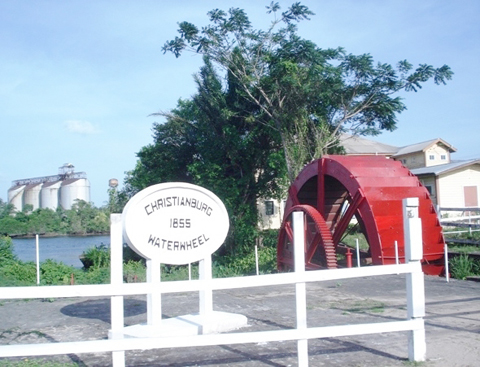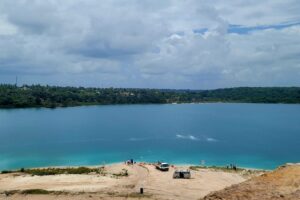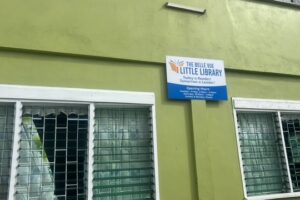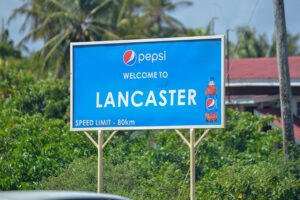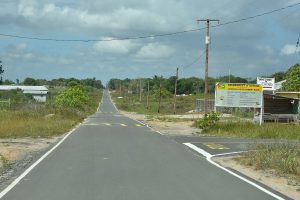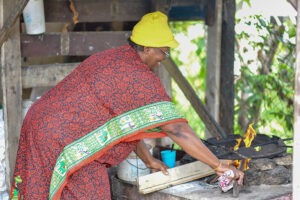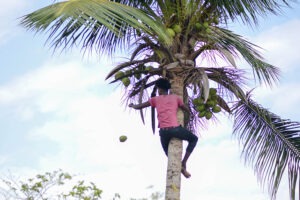Christianburg was one of Linden’s first village. It was this village that the Dutch settled at the ending of the 18th century. The area which was a former sugar estate, was originally known as Stabroek. Governor Christian Finette, then later renamed the area partly after his wife’s family, the Burgs and then he administered the settlement’s affairs during the early years of the 19th century.
One of the earliest engineering structures to be built in this town was the Christianburg waterwheel. This is so since a hydro-powered sawmill was needed to improve the production of logs and reducing the cost associated with it in which the waterwheel was a part of. This was on a plantation during the latter half of the 1800s. It can therefore be said that, the waterwheel pioneered the supply of hydroelectricity in the Demerara region.
Location of the waterwheel
The Christianburg waterwheel is located next to Wismar in Linden, Upper Demerara-Berbice Guyana.
History of the Christianburg waterwheel
After the English invasion in 1803, John Dagleish Patterson, a Scottish engineer was appointed to establish a quarters for government officials. The commencement of logs begun when Patterson acquired a small number of vessels from the indigenous people in which the first years were proven to be extremely difficult.
Patterson still persisted courageously given the hurdles he faced. Instead of giving up he found a solution whereby Christianburg was surveyed and Katabulli creek was identified as the ideal point of operation for the production of timber. Due to the power of the water flowing through the creek from the forest into the Demrara River, there was enough to allow the constrution of a hydro-powered sawmill. The waterwheel came into play so as to improve the output of the sawmill.
The logs were tied together and strung alongside a punt and floated downstream. This mode of production was dangerous and time consuming resulting in a high cost of production. This was how logging operations began.
The waterwheel was built by Mirrlees, Tait & Watson previously known as P. and W. McOnie, a company from Glasgow and the name can be seen on numerous places along the structure. In 1840, the company started as an engineering partnership to manufacture sugar cane processing machinery.
It became a partnership as other individuals joined over the years which was between 1858 to 1868. Moreover, in 1895 the large iron wheel was installed by Scottish engineer John Dagleish Patterson as a prime mover for his sawmilling equipment which was the only one of its kind.
However, during the 1950s the hydro-powered sawmill ceased operations and was dismantled. Nevertheless, the waterwheel which is one of the more famous landmarks in Linden still remains as a tangible reminder and part of Linden’s industrial heritage. It also remains as an example of how the timber industry was mechanized to exploit the rich natural resources of the area in Linden.
Prior to the waterwheel, another famous landmark, the Christianburg magistrate court was located in the same area and both landmarks were established by the Pattersons. The building which was said to be one of the largest wooden structures to be built during the 1830s once serve as the residence for the wealthy logging family but, was destroyed by fire.The edifice continues to exist to this date even though it is now modified to some extent to suit the purposes of a modern day Magistrate’s Court. Moreover architectural features such as brick columns and wooden jalousies are still intact.
Features of the waterwheel
The giant red Waterwheel is said to be one of the most popular sites in history for visitors in the town of Linden. The almost two hundred year old landmark is well known among school children from other communities who would visit the site from time to time on school tours.
Apart from domestic purposes, water was used for harnessing electricity to power the sawmill which was made possible by the waterwheel as it traps energy from the fast flowing creek. As a result of this, students receive the opportunity to have direct contact with the historic fixture sitting on the periphery of the equally famous Katapulli creek.
Like the many other monuments around, the waterwheel is a reminder of our history and as such, it is important that its continuity is ensured. Adding to that, citizens ought to take an active role in ensuring the long-term survival of Guyana’s patrimony by exercising care and respect at all times when visiting monuments and heritage sites.
Article References
- http://nationaltrust.gov.gy/historic-linden/
- https://www.kaieteurnewsonline.com/2009/08/09/christianburg-lindens-first-village/
- https://www.kaieteurnewsonline.com/2017/04/10/rockstone-kwakwani-waterfront-blue-lakes-and-christianburg-waterwheel/
- https://www.stabroeknews.com/2007/features/11/15/history-this-week-13/
- http://guyanachronicle.com/2010/05/30/christianburg-waterwheel
- https://en.wikipedia.org/wiki/Linden,_Guyana#Christiansburg_Water_Wheel

